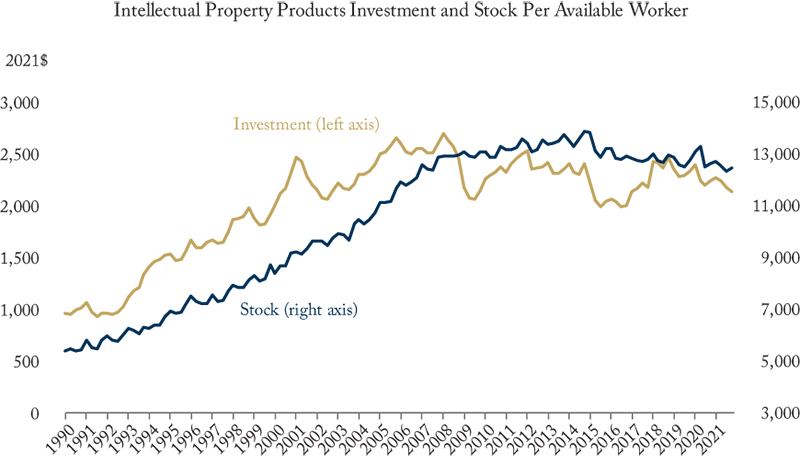To: Canada’s Minister of Finance, Chrystia Freeland
From: Mawakina Bafale and William B.P. Robson
Date: May 9, 2022
Re: Canadian Investment in Intellectual Property Products is Too Low
Minister, your 2022 federal budget rightly highlighted the importance of economic growth for Canadians’ future prosperity and the fiscal health of Canadian governments.
Much of the budget’s message was sober. It cited OECD projections ranking Canada’s prospects for real growth in the decades ahead last among all OECD countries. Your budget also pointed to a major reason for this bleak prospect, saying: “Solving Canada’s main innovation challenges – a low rate of private business investment in research, development, and the uptake of new technologies – is key to growing our economy and creating good jobs.”
We agree that low investment in general is a problem, and with the emphasis you placed in your budget on investment in intellectual property products (IPP). Along with business investment in non-residential structures, and in machinery and equipment, investment in such assets as computer software, databases, mineral exploration and other intangibles equips workers with tools to raise their output and incomes.
The surge in digital activity during the pandemic highlighted the transformational power of IPP investments. Such investment may be uniquely important in driving innovation and higher productivity in the industries that will be most important in the future.
That is why the latest data on business investment from Statistics Canada are so discouraging. Business investment in IPP has been lacklustre for years, and there is no sign that the pandemic made any positive difference. Lacklustre aggregate investment combined with a growing workforce means that IPP investment per available worker is going nowhere.
Measured in constant 2021 dollars, IPP investment per available worker was $2,100 in the fourth quarter of 2021 – the same level that it was more than two decades ago (the gray line in Figure).

IPP, by their nature, tend to depreciate fast. It takes a lot of new IPP investment every year to build up the stock of IPP capital per worker, and Canadian IPP investment has fallen short of that mark. The stock of IPP capital per available worker in real terms peaked in 2014. By the fourth quarter of 2021, it was down 10 percent from that mark (the blue line in the Figure.) Canadian workers are less and less equipped with intangible capital – not promising for leading-edge jobs.
The situation of their US counterparts is starkly different. US business investment in IPP products is up sharply. In 2021, US businesses invested more than $8,000 (in Canadian dollars) in IPP per member of the US workforce. For every dollar of new IPP capital enjoyed by the average member of the US workforce in 2021, the average Canadian enjoyed only 27 cents – not promising for future competitiveness.
A recent release by Statistics Canada showed that labour productivity in Canada fell 6 percent in 2021, with productivity in the business sector falling 7 percent. While that grim number reflects some extraordinary circumstances – notably the rebound in lower-productivity service jobs as the effects of the pandemic abated – it is incompatible with robust growth in earnings. With the unemployment rate at a record low, more capital per worker is an imperative.
Canadian workers need new, better non-residential structures and new, better machinery and equipment. Perhaps most of all, they need new, better software and other intangible capital that will help them raise their output, earn higher wages, and compete with their counterparts abroad.
The rebound from the pandemic is not over, and there is reason to hope that IPP investment will show more life this year. In its latest Monetary Policy Report, the Bank of Canada indicates that businesses actively plan to increase investment – particularly in digital technologies and automation. But actual performance to date has shown little life, even as IPP investment in the United States roars ahead.
Your budget mentioned a potential lower corporate income tax rate on income from intellectual property developed in Canada. That is the kind of federal measure that might make a difference in this crucial area. IPP investment in Canada is ominously low. Raising it is a priority – for Canadian businesses, and for your government.
Mawakina Bafale is a Research Assistant at the C.D. Howe Institute, where William B.P. Robson is CEO.
To send a comment or leave feedback, email us at blog@cdhowe.org.
The views expressed here are those of the authors. The C.D. Howe Institute does not take corporate positions on policy matters.





